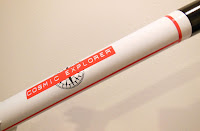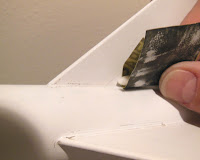I was expecting big damage but there was just a nicked fin.
Here's one way to re-paint without respraying the whole model.
The fin edge was filled with CWF and sanded smooth without removing much blue paint around the filled area.
The model was masked without pressing down the edges of the tape.
The tape edges were peeled back almost like flower petals. The inset picture shows the view from the front.
Masking this way prevents the new color from forming a hard edge.
Shoot the paint directly from the side, not down or at an angle.

A little of the sprayed paint will get into the lifted "soft edge" and will feather in with the original coat of paint.
This picture Shows the gray primer shot first.
The tape was peeled back to show the soft blend.
Sand the primer lightly, not going down to the blue underneath.

The tape was rolled back up before the blue was shot.
Here I've pulled back the tape to show the blue blend.
 After the new paint has dried, use a little polishing compound to polish the soft blend area.
After the new paint has dried, use a little polishing compound to polish the soft blend area.The over spray line (at the tape soft blend) won't be as glossy as the earlier paint finish. The polishing compound should help bring back some of the gloss.
It's not perfect, but better than it looked after the hard landing.
















































